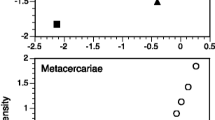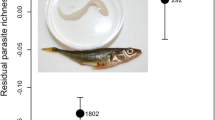Abstract
The relationship between host density and parasitism depends on a parasite’s life history. The abundance of a directly transmitted contagious parasite should increase with host density, whereas the abundance of a directly transmitted parasite that seeks its host might decrease due to the encounter-dilution effect. For parasites with complex life cycles, previous studies have found no association between parasite abundance and host density. We tested the relationship between host density and metacercarial abundance of a trematode parasite (Posthodiplostomum minimum) in two species of centrarchid fishes (Lepomis macrochirus and L. auritus) from eight small creeks. We found that host density was negatively associated with parasite abundance. Thus, our study represents the first evidence of the encounter-dilution effect for a parasite with complex life cycle in a natural system. We also report a positive association between total P. minimum population abundance and Lepomis spp. density, indicating that at low host density, cercarial mortality could moderate the encounter-dilution effect.


Similar content being viewed by others
References
Anderson, R. M., 1978. Population dynamics of snail infection by miracidia. Parasitology 77: 201–224.
Anderson, R. M. & R. M. May, 1978. Regulation and stability of host-parasite population interactions: I. Regulatory processes. Journal of Animal Ecology 47: 219–247.
Anderson, S. M., R. A. Fiorillo, T. J. Cook & W. I. Lutterschmidt, 2015. Helminth parasites of two species of Lepomis (Osteichthyes: Centrarchidae) from an urban watershed and their potential use in environmental monitoring. Georgia Journal of Science 73: 123–135.
Arneberg, P., 2001. An ecological law and its macroecological consequences as revealed by studies of relationships between host densities and parasite prevalence. Ecography 24: 352–358.
Arneberg, P., A. Skorping, B. Grenfell & A. F. Read, 1998. Host densities as determinants of abundance in parasite communities. Proceedings of the Royal Society B: Biological Sciences 265: 1283–1289.
Avault Jr., J. W. & R. O. Smitherman, 1965. Experimental host specificity of Posthodiplostomum minimum. Experimental Parasitology 17: 268–270.
Bedinger Jr., C. A. & T. G. Meade, 1967. Biology of a new cercaria for Posthodiplostomum minimum (Trematoda: Diplostomidae). The Journal of Parasitology 53: 985–988.
Bush, A. O., K. D. Lafferty, J. M. Lotz & A. W. Shostak, 1997. Parasitology meets ecology on its own terms: Margolis et al. revisited. The Journal of Parasitology 83: 575–583.
Christensen, N. O., P. Nansen & F. Frandsen, 1976. Molluscs interfering with the capacity of Fasciola hepatica miracidia to infect Lymnaea truncatula. Parasitology 73: 161–167.
Côté, I. M. & R. Poulin, 1995. Parasitism and group-size in social animals: a metaanalysis. Behavioral Ecology 6: 159–165.
Crofton, H. D., 1971. A quantitative approach to parasitism. Parasitology 62: 179–193.
Dobson, A. P., 1990. Models for multi-species parasite-host communities. In Esch, G. W., A. O. Bush & J. M. Aho (eds), Parasite communities: patterns and processes. Chapman and Hall, London: 261–288.
Fauchald, P., R. Rodven, B.-J. Bardsen, K. Langeland, T. Tveraa, N. G. Yoccoz & R. A. Ims, 2007. Escaping parasitism in the selfish herd: age, size and density-dependent warble fly infestation in reindeer. Oikos 116: 491–499.
Ferguson, M. S., 1943. Experimental studies on the fish hosts of Posthodiplostomum minimum (Trematoda: Strigeida). The Journal of Parasitology 29: 350–353.
Hoffman, G. L., 1958. Experimental studies on the cercaria and metacercaria of a strigeoid trematode, Posthodiplostomum minimum. Experimental Parasitology 7: 23–50.
Hoffman, G. L., 1967. Parasites of North American Freshwater Fishes. University of California Press, Berkeley.
Hunter III, G. W. & W. S. Hunter, 1940. Studies on the development of the metacercaria and the nature of the cyst of Posthodiplostomum minimum (MacCallum 1921) (Trematoda; Strigeata). Transactions of the American Microscopical Society 59: 52–63.
Johnson, P. T. J., D. L. Preston, J. T. Hoverman, J. S. Henderson, S. H. Paull, K. L. D. Richgels & M. D. Redmond, 2012. Species diversity reduces parasite infection through cross-generational effects on host abundance. Ecology 93: 56–64.
Klak, G. E., 1940. Neascus infestation of black-head, blunt-nosed, and other forage minnows. Transactions of the American Fisheries Society 69: 273–278.
Lane, B., T. Spier, J. Wiederholt & S. Meagher, 2015. Host specificity of a parasitic fluke: is Posthodiplostomum minimum a centrarchid-infecting generalist or specialist? The Journal of Parasitology 101: 6–17.
Lutterschmidt, W. I., J. F. Schaefer & R. A. Fiorillo, 2007. The ecological significance of helminth endoparasites on the physiological performance of two sympatric fishes. Comparative Parasitology 74: 194–203.
Martin, S. L. & W. I. Lutterschmidt, 2013. A checklist to the common cyprinid and centrarchid fishes of the Bull and Upatoi creeks watershed of Georgia with a brief glimpse of correlative urban influences and land use. Southeastern Naturalist 12: 769–780.
May, R. M. & R. M. Anderson, 1978. Regulation and stability of host-parasite population interactions: II. Destabilizing processes. Journal of Animal Ecology 47: 249–267.
Mettee, M. F., P. E. O’Neil & J. M. Pierson, 1996. Fishes of Alabama and the Mobile Basin. Oxmoor House, Birmingham, Ala.
Miller, J. H., 1954. Studies on the life history of Posthodiplostomum minimum (MacCallum 1921). The Journal of Parasitology 40: 255–270.
Moore, J., D. Simberloff & M. Freehling, 1988. Relationships between bobwhite quail social-group size and intestinal helminth parasitism. American Naturalist 131: 22–32.
Mooring, M. S. & B. L. Hart, 1992. Animal grouping for protection from parasites: selfish herd and encounter-dilution effects. Behaviour 123: 173–193.
Page, L. M. & B. M. Burr, 1991. A Field Guide to Freshwater Fishes of North America North of Mexico. Houghton Mifflin Company, Boston, Massachusetts.
Pflieger, W. L., 1997. The Fishes of Missouri. Missouri Dept. of Conservation, Jefferson City.
Rifkin, J. L., C. L. Nunn & L. Z. Garamszegi, 2012. Do animals living in larger groups experience greater parasitism? A meta-analysis. American Naturalist 180: 70–82.
Ross, S. T., 2002. Inland Fishes of Mississippi. University Press of Mississippi, Jackson.
Sonnenholzner, J. I., K. D. Lafferty & L. B. Ladah, 2011. Food webs and fishing affect parasitism of the sea urchin Eucidaris galapagensis in the Galapagos. Ecology 92: 2276–2284.
Strona, G. & K. D. Lafferty, 2012. How to catch a parasite: Parasite Niche Modeler (PaNic) meets Fishbase. Ecography 35: 481–486.
Stumbo, A. D., C. T. James, C. P. Goater & B. D. Wisenden, 2012. Shoaling as an antiparasite defence in minnows (Pimephales promelas) exposed to trematode cercariae. Journal of Animal Ecology 81: 1319–1326.
Turner, G. F. & T. J. Pitcher, 1986. Attack abatement: a model for group protection by combined avoidance and dilution. The American Naturalist 128: 228–240.
Acknowledgments
We thank S.M. Anderson, R.A. Fiorillo L. Dent, D.S. Millican, and D.K. Wasco for assistance related to this research. We thank K.D. Lafferty, A.M. Kuris, A. Smith-Herron, T.J. Cook, and two anonymous reviewers for useful discussions and comments on the manuscript. This work was supported by a grant from the Engineer Research and Development Center (ERDC) and the Civil Engineering Research Lab (CERL) of the US Army Corps of Engineers (ERDC-CERL Contract #DACA 42-00-C-0047) to W.I.L. We acknowledge the assistance provided by Gordon A. Plishker and all personnel of the Texas Research Institute for Environmental Studies (TRIES) at Sam Houston State University. We also thank Hugh Westbury of the Strategic Environmental Research and Development Program (SERDP), Ecosystem Management Project (SEMP), and Harold (Hal) Balbach of the US Army ERDC and CERL for their sincere interest in and support of this project.
Author information
Authors and Affiliations
Corresponding author
Additional information
Handling editor: Lee B. Kats.
Rights and permissions
About this article
Cite this article
Buck, J.C., Lutterschmidt, W.I. Parasite abundance decreases with host density: evidence of the encounter-dilution effect for a parasite with a complex life cycle. Hydrobiologia 784, 201–210 (2017). https://doi.org/10.1007/s10750-016-2874-8
Received:
Revised:
Accepted:
Published:
Issue Date:
DOI: https://doi.org/10.1007/s10750-016-2874-8




